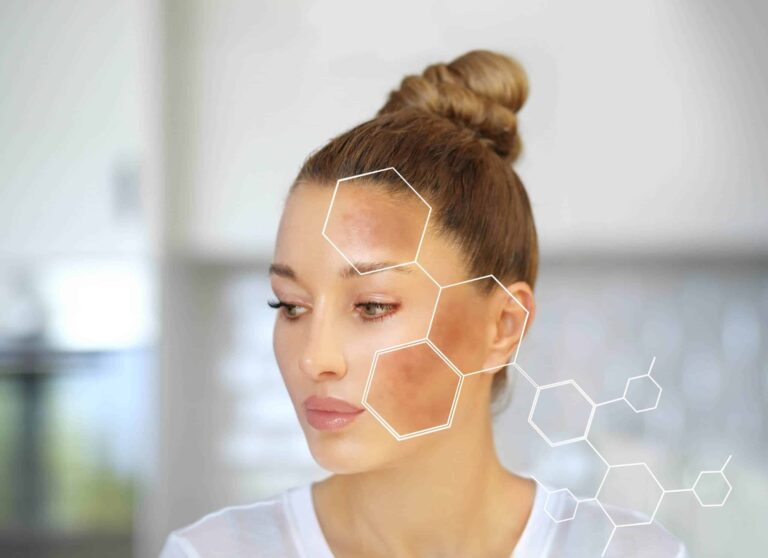Whether it’s dark spots, melasma, or sun damage, we’ve all been there, and it’s something that affects so many of us, regardless of age or skin type. Keep reading to learn what causes hyperpigmentation, why certain people are more prone to it, and how you can treat it effectively.
What Is Hyperpigmentation?
Hyperpigmentation is the darkening of an area of skin caused by an excess production of melanin—the pigment responsible for the color of your skin, hair, and eyes. While some degree of skin pigmentation is normal, hyperpigmentation occurs when certain spots or areas produce too much melanin, leading to darker patches.
These dark spots can form anywhere on the body, but they’re most commonly found on the face, especially in areas that are regularly exposed to the sun. We often see it as:
- Sunspots or Age Spots: Caused by prolonged sun exposure.
- Melasma: Large, brown patches often triggered by hormonal changes, like pregnancy or birth control.
- Post-inflammatory hyperpigmentation: Dark spots left behind after a pimple, cut, or other skin injury heals.
Who’s More Prone to Hyperpigmentation?
It’s important to note that hyperpigmentation can affect anyone, but certain factors and ethnicities may make some individuals more susceptible. People with darker skin tones—such as those of African, Hispanic, Asian, or Middle Eastern descent—are more likely to develop hyperpigmentation, especially melasma. This is due to the higher concentration of melanin in their skin, which can react more intensely to triggers like UV exposure, inflammation, or hormonal changes.
While hyperpigmentation is more common in people with deeper skin tones, anyone can develop dark spots, especially if they’ve spent time in the sun without proper protection. It’s important to recognize that this condition doesn’t discriminate!
What Causes Hyperpigmentation?
As mentioned, there are a few key triggers that can lead to the development of hyperpigmentation. These include:
- Sun Exposure: UV rays stimulate melanin production, leading to dark spots. The more unprotected exposure you have to the sun, the higher the chances of developing hyperpigmentation.
- Hormonal Changes: Pregnancy, birth control, and other hormonal shifts can trigger melasma, which is especially common in women.
- Inflammation: Pimples, eczema, cuts, and other forms of skin irritation can lead to post-inflammatory hyperpigmentation. Your body produces more melanin to repair the skin, resulting in darker patches.
- Medication: Certain medications, especially those that make your skin more sensitive to light, can also increase your risk of developing hyperpigmentation.
How to Treat Hyperpigmentation?
While hyperpigmentation can be stubborn, there are so many effective treatments available today to help reduce and even eliminate dark spots. Below will highlight some of the most effective options.
1. Topical Skincare Ingredients
The first step in treating hyperpigmentation is addressing it from the inside out with the right skincare routine. The key is consistency, and using the right ingredients is crucial to fading those dark spots over time. Here are some of the best ingredients to look for:
- Vitamin C: This powerful antioxidant helps brighten dark spots by inhibiting melanin production.
- Niacinamide (Vitamin B3): Helps to lighten pigmentation and even out skin tone by reducing melanin production and promoting a more uniform skin surface.
- Retinoids: Retinol or prescription-strength tretinoin can help accelerate cell turnover, promoting the shedding of dark skin cells and revealing brighter skin.
- Alpha Hydroxy Acids (AHAs): Lactic and glycolic acids exfoliate the skin’s surface, encouraging the removal of dead skin cells and the fading of dark spots.
- Licorice Extract: Known for its brightening properties, licorice helps lighten existing pigmentation and prevents new dark spots from forming.
Using these ingredients regularly, along with a good moisturizer, will set the stage for clear, radiant skin.
2. Mineral Sunscreens
I can’t stress this enough—sunscreen is your best friend when it comes to treating and preventing hyperpigmentation. Exposure to UV rays can worsen existing spots and trigger new ones, so even if you’re on a treatment plan, skipping sunscreen will set you back.
For those with sensitive skin or a tendency to break out, I highly recommend mineral sunscreens (also called physical sunscreens). These contain active ingredients like zinc oxide and titanium dioxide that sit on top of the skin and reflect UV rays, providing broad-spectrum protection. Choose a sunscreen with at least SPF 30 and wear it every day—yes, even on cloudy days!
3. Microneedling
Microneedling is one of my favorite treatments for hyperpigmentation because it’s not only effective but also minimally invasive. During this treatment, tiny needles are used to create micro-channels in the skin. This stimulates collagen production and helps your skin absorb topical treatments (like serums with vitamin C or niacinamide) much better.
Microneedling can help reduce the appearance of dark spots over time by accelerating the skin’s healing process and promoting more even skin tone. Multiple sessions are typically recommended, spaced about a month apart, for the best results.
4. Chemical Peels
Chemical peels are another fantastic option for addressing hyperpigmentation. These treatments use different types of acids to exfoliate the skin, remove the top layer of dead skin cells, and stimulate collagen production. The result is a smoother, more even skin tone. Depending on the severity of your hyperpigmentation, we may recommend a light peel or a deeper one for more dramatic results. As always, post-treatment sun protection is critical to prevent further pigmentation!
Final Thoughts
If you’re dealing with hyperpigmentation, you’re definitely not alone. The good news is, there are so many effective ways to manage and reduce dark spots. A combination of the right topical ingredients, consistent use of mineral sunscreen, and professional treatments like microneedling and chemical peels can help you achieve the even, radiant skin you deserve.
If you’re ready to tackle hyperpigmentation head-on, I’d love to help you create a personalized treatment plan. Don’t hesitate to reach out or schedule a consultation—we’re here to support you on your skincare journey!


